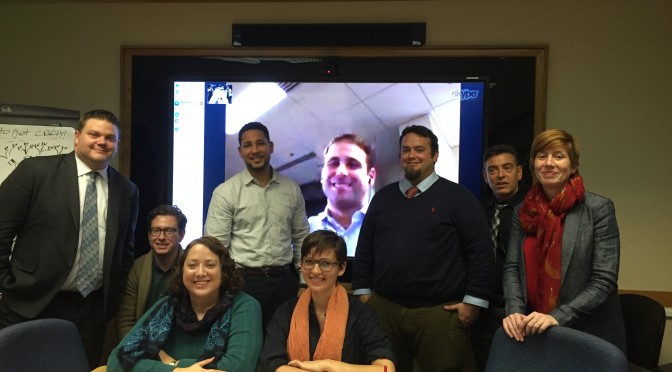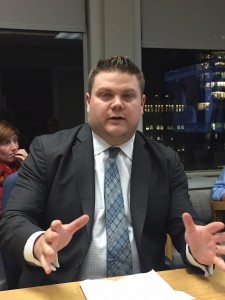Congratulations to our Fall 2015 Capstone students in the Labor Studies MA program! With the guidance of Professor Michael Murphy (connecting from Washington DC), our MA candidates engaged the audience in great conversations about their research topics.
Richard Gorgoglione:
“The WPA and the Transformation of Staten Island”
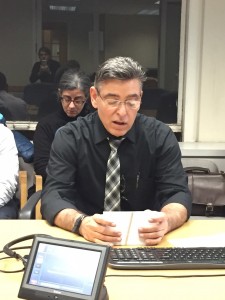 This research project explores how the WPA contributed to Staten Island and its residents. Structures that still stand today are monuments to the men and women of that era who labored during one of the darkest periods in economic history. The WPA, even though short-lived (1935 to 1943) has transformed Staten Island into the borough of parks, considered today a cultural and recreational gem.
This research project explores how the WPA contributed to Staten Island and its residents. Structures that still stand today are monuments to the men and women of that era who labored during one of the darkest periods in economic history. The WPA, even though short-lived (1935 to 1943) has transformed Staten Island into the borough of parks, considered today a cultural and recreational gem.
Francisco Gomez:
“Engaging in a Contemporary Debate about Technology and the Workplace in New York City”
Blithe Riley:
“Workers and the Sharing Economy: New York City Unions Fight Uber and AirBnB”
Edward Kennedy:
“Time to Get Crafty: Organizing Attorneys at the Edge of a Profession in the Intercises of Federal Regulation”
I examine the plight of temporary contract attorneys in a restructured legal market. I then propose a plan of action for the reinvigoration of craft or occupational unionism in spite of adverse federal law through a synergy of three organizational forms and the application of the strategies of New Labor.
Paz Petersson:
“Global Grey Area: The Growing Nonstandard Workforce”
Karen Master:
“Building Voices From the Floor: Labor-Management Partnerships and Resident Physician Unionization”
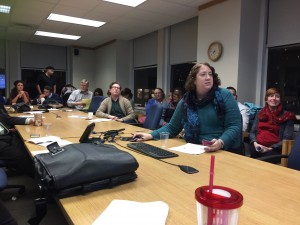 This paper examines the work of CIR/SEIU around experiments engaging unionized resident physicians in quality improvement. I found that this area of work is best analyzed academically in the context of labor-management partnerships, which have strong implications for best practices that fit with observations about the benefits and potential pitfalls of the work. Partnering on quality improvement is a way to capitalize on current healthcare trends to enhance the worker voices of resident physicians and broaden a union leadership base, potentially strengthening the power of the union. However, it is vital that the union also find the right management partners and preserve its autonomy and ability to address other workplace issues.
This paper examines the work of CIR/SEIU around experiments engaging unionized resident physicians in quality improvement. I found that this area of work is best analyzed academically in the context of labor-management partnerships, which have strong implications for best practices that fit with observations about the benefits and potential pitfalls of the work. Partnering on quality improvement is a way to capitalize on current healthcare trends to enhance the worker voices of resident physicians and broaden a union leadership base, potentially strengthening the power of the union. However, it is vital that the union also find the right management partners and preserve its autonomy and ability to address other workplace issues.
Chris Maisano:
“Rivalry and Revitalization in the U.S. Labor Movement: The Case of SSEU and AFSCME District Council Local 371”
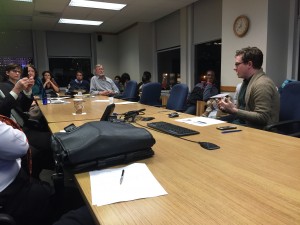 Rival unionism has long been anathema to the U.S. labor movement. Opposition to inter-union competition has united labor activists across ideological and strategic divides, establishing rivalry, competition, and “raiding” as the worst crimes against trade union morality one could possibly commit. However, despite the official taboo on rival unionism it has been a consistent feature of U.S. labor movement activity since the nineteenth century. Not only has it been a constant presence in U.S. labor history, inter-union competition has made a positive contribution to both union growth and internal reform at critical junctures in the development of American unionism. A case study of the rivalry between the independent Social Service Employees Union and Local 371 (AFSCME District Council 37) in New York during the 1960s should be counted among the foremost examples of positive-sum inter-union competition in U.S. labor history. The rivalry was extremely beneficial for both unions and their members, and in the long run the incumbent union (Local 371) benefited the most from competition. The emergence of SSEU as a serious competitor forced Local 371 to undergo a process of internal reform that it might not have undertaken otherwise. Instead of ignoring or dismissing rival unionism, scholars should reconsider the potential contributions it might make to the cause of labor movement revitalization today.
Rival unionism has long been anathema to the U.S. labor movement. Opposition to inter-union competition has united labor activists across ideological and strategic divides, establishing rivalry, competition, and “raiding” as the worst crimes against trade union morality one could possibly commit. However, despite the official taboo on rival unionism it has been a consistent feature of U.S. labor movement activity since the nineteenth century. Not only has it been a constant presence in U.S. labor history, inter-union competition has made a positive contribution to both union growth and internal reform at critical junctures in the development of American unionism. A case study of the rivalry between the independent Social Service Employees Union and Local 371 (AFSCME District Council 37) in New York during the 1960s should be counted among the foremost examples of positive-sum inter-union competition in U.S. labor history. The rivalry was extremely beneficial for both unions and their members, and in the long run the incumbent union (Local 371) benefited the most from competition. The emergence of SSEU as a serious competitor forced Local 371 to undergo a process of internal reform that it might not have undertaken otherwise. Instead of ignoring or dismissing rival unionism, scholars should reconsider the potential contributions it might make to the cause of labor movement revitalization today.
Jim Dandeneau:
“Crisis of Infinite Exploitation: The Fight for Fair Pay and Creative Control in the Comic Book Industry”

